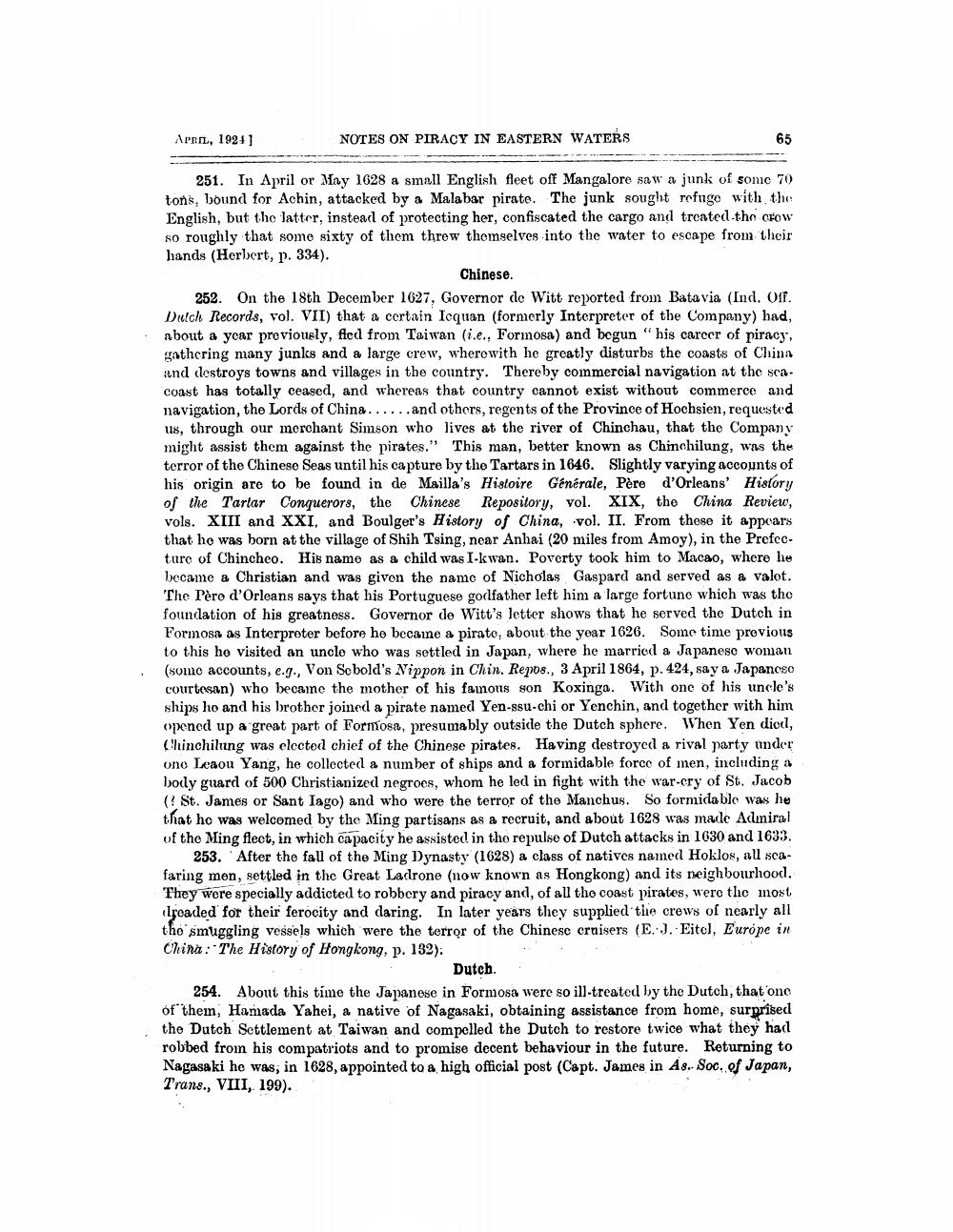________________
Apr, 1924
NOTES ON PIRACY IN EASTERN WATERS
251. In April or May 1628 a small English fleet off Mangalore saw a junk of some 70 tons, bound for Achin, attacked by a Malabar pirate. The junk sought refugo with the English, but the latter, instead of protecting her, confiscated the cargo and treated the crow so roughly that some sixty of them threw themselves into the water to escape from their hands (Herbert, 19. 334).
Chinese. 252. On the 18th December 1627, Governor cle Witt reported from Batavia (Ind. O1r. Dulch Records, vol. VII) that a certain Icquan (formerly Interpreter of the Company) had, about a year previously, fted from Taiwan (i.e., Formosa) and begun " his career of piracy, gathering many junks and a large crew, wherewith he greatly disturbs the coasts of China and destroys towns and villages in the country. Thereby commercial navigation at the sca. coast has totally ceased, and whereas that country cannot exist without commerce and navigation, the Lords of China......and others, regents of the Province of Hochsien, requested us, through our merchant Simson who lives at the river of Chinchau, that the Company might assist them against the pirates." This man, better known as Chinchilung, was the terror of the Chinese Seas until his capture by the Tartars in 1646. Slightly varying accounts of his origin are to be found in de Mailla's Histoire Générale, Père d'Orleans' Hislory of the Tarlar Conquerors, the Chinese Repository, vol. XIX, the China Review, vols. XIII and XXI, and Boulger's History of China, vol. II. From these it appears that ho was born at the village of Shih Tsing, near Anhai (20 miles from Amoy), in the Prefecture of Chincheo. His name as a child was I-kwan. Poverty took him to Macao, where he became a Christian and was given the name of Nicholas Gaspard and served as a valot. The Pèro d'Orleans says that his Portuguese godfather left him a large fortune which was the foundation of his greatness. Governor de Witt's letter shows that he served the Dutch in Formosa as Interproter before he becaine a pirato, about the year 1626. Some time provious to this ho visited an uncle who was settled in Japan, where he married a Japanese woman (somo accounts, e.g., Von Sebold's Nippon in Chin. Repos., 3 April 1864, p. 424, say a Japanoso courtesan) who became the mother of his famous son Koxinga. With one of his uncle's ships ho and his brother joined a pirate named Yen-ssu-chi or Yenchin, and together with him opened up a great part of Formosa, presumably outside the Dutch sphere. When Yen diod, Chinchilung was elected chief of the Chinese pirates. Having destroyed a rival party under one Leaou Yang, he collected a number of ships and a formidable force of men, including a body guard of 500 Christianized negroes, whom he led in fight with the war-cry of St. Jacob ( St. James or Sant Iago) and who were the terror of the Manchus. So formidable was he that ho was welcomed by the Ming partisans as a recruit, and about 1628 was made Admiral of the Ming fleet, in which capacity he assisted in the repulse of Dutch attacks in 1630 and 1633.
253. After the fall of the Ming Dynasty (1628) a class of natives named Hoklos, all scafaring mon, settled in the Great Ladrone (now known as Hongkong) and its neighbourhood. They were specially addicted to robbery and piracy and, of all tho coast pirates, were the most
lreaded for their ferocity and daring. In later years they supplied the crews of nearly all the smuggling vessels which were the terror of the Chinese cruisers (E. J. Eitel, Europe in China: The History of Hongkong, p. 132):
Dutch. 254. About this time the Japanese in Formosa were so ill-treated by the Dutch, that one of them, Hamada Yahei, a native of Nagasaki, obtaining assistance from home, surprised the Dutch Settlement at Taiwan and compelled the Dutch to restore twice what they hac robbed from his compatriots and to promise decent behaviour in the future. Returning to Nagasaki he was, in 1628, appointed to a high official post (Capt. James in A8. Soc. of Japan, Trans., VIII, 199).




